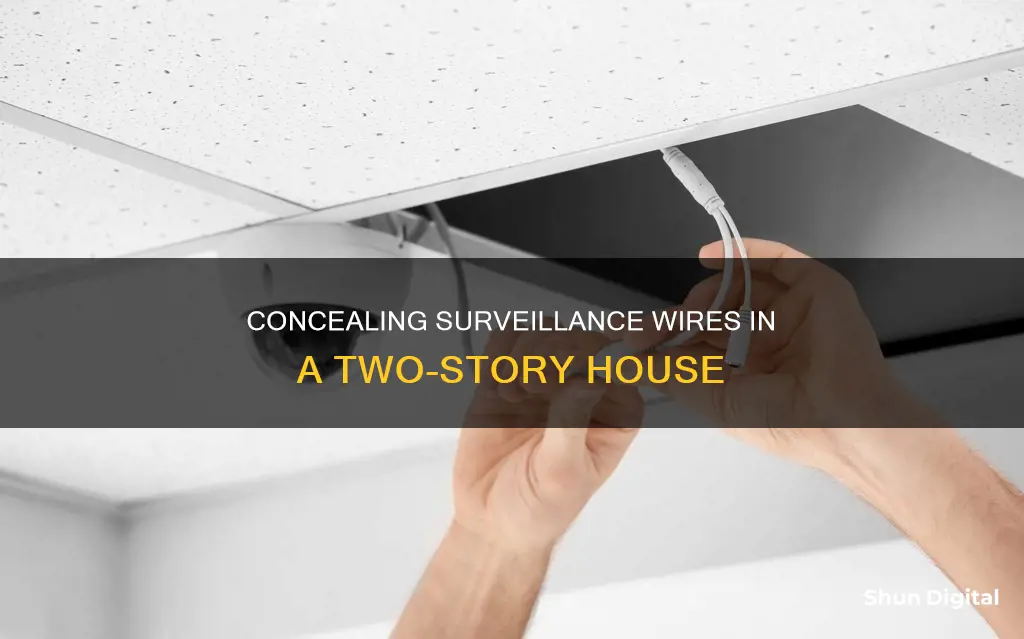
Running surveillance camera wires in a two-story house can be a challenging task, but with careful planning and execution, it is certainly achievable. Here are the steps you need to follow to ensure a successful installation:
- Design the central surveillance hub: Determine the location of your NVR/DVR, which will serve as the central surveillance hub. Choose a place that is easily accessible and allows for convenient wiring to different parts of the house.
- Turn off the power: Before beginning any work, make sure to turn off the power to ensure your safety and prevent damage to devices.
- Drill holes: Identify the locations for your cameras and drill holes where the outlets will be. Use a metal coat hanger to check for any obstructions inside the walls.
- Create a gap/hole for wires: Make sure the gap or hole is large enough to accommodate the maximum number of wires you expect to run. Leave a few extra feet of wire for termination and future reorganisation. Label the ends of the cables to avoid confusion later.
- Drill holes in the top or bottom wall plate: Go to the desired locations for your cameras, such as the attic, soffit, basement, or crawl space, and drill holes in the wall plate.
- Attach wires with fish tape: Use fish tape to guide the security camera wires through the drilled holes.
- Run security camera wires to their destinations: With the help of a partner, carefully run the security camera wires to their respective destinations. Use wire protection covers or conduits to protect the cables.
- Plan the security camera wire route: If you need to install cameras outside, plan a short and easy route for burying your conduits.
- Use PVC or metal conduits: Protect your outdoor wires from tampering by humans and animals using PVC or metal conduits.
- Power your outdoor cameras: For PoE security cameras, use a CAT5/6 cable to provide both data connection and power. For wireless security cameras, ensure a power supply by running wires to a waterproof and weatherproof outlet.
- Mark and drill holes: Mark the spots where you need to cut holes and carefully drill them to run the security camera wires from your house.
- Bury electrical wires/network cables: Follow the National Electric Code (NEC) guidelines and bury PVC conduits at least 18 inches deep, while metal conduits should be buried at least 6 inches deep.
- Pull security camera wires: With one person feeding the wires and another pulling, slowly pull the security camera wires through the conduits. Ensure the wires remain untangled to avoid damage.
| Characteristics | Values |
|---|---|
| Number of wires | 5-6 |
| Wire management | All wires should gather at one common spot |
| Bushing | 1-2 inches |
| Drill bits | N/A |
| Conduit | N/A |
| Placement | Attic, soffit, basement, crawlspace |
| Tools | Fish tape, drill, metal coat hanger, wire guard, tube, security camera wire protectors, cable guard, conduit, RJ-45 connectors, crimping tool, POE injector, POE switch, electrical tape, silicone caulking, outdoor-rated cables |
What You'll Learn
- Design the central surveillance hub before snaking security camera cabling
- Turn off the power when running security camera wires
- Drill a hole in the wall and check for obstructions
- Allow a few feet of extra wire for termination and future reorganisation
- Attach the wires with fish tape to fish your security camera wires

Design the central surveillance hub before snaking security camera cabling
When installing security cameras, it is important to first design the central surveillance hub before snaking security camera cabling. This is because the placement of your NVR/DVR (the central surveillance hub) in your house determines the route of wiring. A thoughtful placement can help you avoid messy wiring.
The central surveillance hub should be placed in an area that is easy to access so that you can hardwire your security camera comfortably from anywhere in your house. Attics and spaces near your internet router are ideal places for NVR/DVR.
Before you begin the installation process, make sure you have the necessary items for wiring your security cameras:
- For PoE security cameras, you will need Cat 5/6 security camera wires.
- For wireless security cameras (without a battery), you will need a security camera wire extension.
- For analog security cameras, you will need RG-59 BNC connectors, an RG-59 stripping tool, RG-59/syv-75-5 coaxial wires, and a standard wire crimp tool.
Additionally, if you need to run underground wires for security cameras to monitor areas like your garden or driveway, PVC/metal conduits are necessary.
Logitech Circle Camera: How Long Does the Battery Last?
You may want to see also

Turn off the power when running security camera wires
When installing security cameras, it is important to prioritise your personal safety and the integrity of your devices. Therefore, turning off the power when running security camera wires is a crucial step.
Before you begin, ensure you have prepared the necessary items for your specific camera wiring. For PoE security cameras, you will need Cat 5/6 security camera wires. Wireless security cameras (without a battery) require a security camera wire extension, and analog security cameras need RG-59 BNC connectors, an RG-59 stripping tool, RG-59/syv-75-5 coaxial wires, and a standard wire crimp tool.
Turning off the power when installing security camera wires is the second step in the process, coming after the design of the central surveillance hub. This step is simple yet vital, as it will protect you from potential electrical hazards and reduce the risk of damaging your devices.
Once the power is off, you can proceed to drill holes for the camera wires. For wireless security cameras and analog security cameras, drill a hole where the outlet will be positioned. You can use a straightened metal coat hanger to check for any obstructions inside the wall. If you are using a Cat 5/6 Ethernet cable, you can simply drill a hole to run the cable from the camera to your router or NVR (network video recorder).
Remember to allow for a few extra feet of wire inside the wall for termination and future reorganisation. It is a good idea to label the ends of the cables to avoid confusion later on.
Charging Camera Batteries: Enercell's Quick Guide
You may want to see also

Drill a hole in the wall and check for obstructions
Drilling a hole in the wall is a crucial step in installing security cameras in your two-story house. Here's a detailed guide on how to do it safely and effectively:
Choose the Right Drill Bit
The type of drill bit you need depends on the material of your walls. Here are some common types of drill bits:
- Drywall Bit: Use this for sheetrock or plasterboard walls. If you plan to hang something heavy, consider drilling into a stud behind the drywall and use a wood drill bit.
- Masonry Bit: If your walls are made of brick, block, concrete, or stone, you'll need a masonry bit.
- Spur Point Bit: For wood paneling or drilling into studs behind hollow walls, a spur point or wood bit is ideal.
- Tile Bit: For drilling into tile, ceramic, or glass walls, use a specialized tile bit to prevent shattering.
Find the Right Spot and Avoid Obstructions
Accidentally drilling into electrical wiring, plumbing, or other obstructions can be dangerous and costly. Here's how to avoid mishaps:
- Avoid drilling above or below light switches, outlets, and other electrical fixtures.
- Use a wire detector or a deep scan stud finder to locate electrical wires and studs.
- Consult a plumber if you're drilling into a bathroom wall or near plumbing or a radiator.
- If your wall is made of drywall, use a stud finder to locate a stud if you need to support heavy items such as mirrors or shelves. Studs are typically spaced 16 inches (41 cm) apart, so you can approximate the location of neighbouring studs.
- Mark the desired drilling spot with a pencil or masking tape.
Drill the Hole
Once you've chosen the right drill bit and found a safe spot, it's time to drill:
- Put on safety goggles and a dust mask to protect your eyes, nose, and lungs from dust and debris.
- Position the drill bit at a 90° angle to the wall and squeeze the trigger gently to start.
- Increase the speed and apply firm, steady pressure as the drill penetrates the wall.
- Continue drilling until you reach the desired depth, then slowly reduce the speed and withdraw the drill bit while it's still running to avoid breaking it.
Remember to always prioritize safety and take the necessary precautions when drilling holes in your walls. If you're unsure or uncomfortable with any part of the process, don't hesitate to seek professional assistance.
Charging Camera Batteries: Empire Adapter Instructions
You may want to see also

Allow a few feet of extra wire for termination and future reorganisation
When installing security cameras, it is important to allow a few feet of extra wire for termination and future reorganisation. This is applicable whether you are installing the cameras inside or outside your house.
The extra wire length is necessary to ensure that you have sufficient cable to connect your cameras to the central surveillance hub, typically located in the attic or near the internet router. It provides flexibility in case you need to reposition your cameras or add new ones in the future.
Planning and Preparation:
- Identify the locations where you want to install security cameras, such as the attic, soffit, basement, or crawl space. Consider the coverage area and any potential obstacles.
- Determine the route of the wiring by designing the central surveillance hub. Place the NVR/DVR (central surveillance hub) in an easily accessible location to simplify the wiring process and avoid messy wiring.
- Gather the necessary tools and materials, including a drill, fish tape, wire cutters, and an appropriate amount of wiring.
Installation Process:
- Turn off the power to ensure safety and prevent damage to devices.
- Drill holes in the desired locations, considering the number of wires and the need for future expansion. The holes should be larger than the maximum amount of wires you expect to run.
- Allow a few feet of extra wire inside for termination and future reorganisation. For example, if you are using CAT5/6 Ethernet cables, leave some additional length on each side of the cables.
- Label the ends of the cables to identify which camera corresponds to each cable. Clear labelling simplifies troubleshooting and future modifications.
- Attach the wires to the fish tape and carefully feed them through the drilled holes, ensuring they are securely connected.
- Run the security camera wires to their destinations, seeking assistance from a partner to feed the wires simultaneously.
- Use wire protectors, such as tubes or conduits, to safeguard the cables and create a neat and professional installation.
- Test the camera locations by temporarily mounting the cameras and monitoring the coverage. Make adjustments as needed to ensure optimal positioning.
- Once you are satisfied with the camera locations, secure the wiring and connect the cameras to the central surveillance hub.
By following these guidelines and allowing extra wire during the installation process, you will have greater flexibility for future modifications and ensure a more organised security camera system in your two-story house.
Explore Lorex Camera Corridor Mode: Maximizing Your Camera's View
You may want to see also

Attach the wires with fish tape to fish your security camera wires
To attach the wires with fish tape to fish your security camera wires, start by pulling out 5 to 6 inches of the fish tape from its casing. Next, strip the ends of the wires to expose the copper wire and twist them together, leaving one wire loose. Attach the loose wire to the end of the fish tape and bend it into a complete loop. Smooth out the wires by tamping them down with your hand. Then, wrap the wires with electrical tape, starting at the point where the wires attach to the fish tape and ending at the cable sheathing. Once that's done, pull the fish tape back slowly and steadily, and have an assistant at the other end to unspool the wires to relieve tension. When the electrical cable appears, make sure there's about a foot or more of the cable exposed, then unwrap and remove the wires from the fish tape.
Modern Camera Focus: Why is it so Poor?
You may want to see also
Frequently asked questions
The first step is to design the central surveillance hub, or the place where you will put your NVR/DVR, which will determine the route of wiring.
The tools and materials you need will depend on the type of camera system you are installing. Generally, you will need items such as security camera wires (Cat 5/6 or RG-59), a drill, a wire crimp tool, and a wire protection cover or conduit.
It is recommended to test camera locations before pulling wires, as small adjustments can make a big difference. Walk around with your phone and take pictures in various locations to find the best spots.
To run security camera wires through the walls, you will need to drill a hole in the wall and use fish tape to "fish" the wires through. Make sure to use security camera wire protectors such as a tube to protect the cables.
If you need to run wires outside, it is recommended to use PVC or metal conduits to protect the wires from tampering and bury the conduits at least 18 inches underground. Drill holes to run the cables from the inside to the outside, and use fish tape to pull the wires through.







